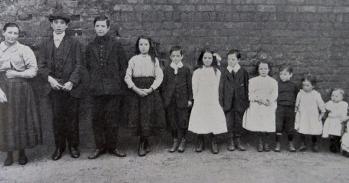
Tomorrow Cambridge historian Dr Ulinka Rublack will give a public talk that will set footwear at the centre of her argument that in neglecting to explore the history of things we miss a golden opportunity to further our understanding of the past.
Tomorrow Cambridge historian Dr Ulinka Rublack will give a public talk that will set footwear at the centre of her argument that in neglecting to explore the history of things we miss a golden opportunity to further our understanding of the past.
"Knightly knees" defined male beauty and majesty.
Shoes are curiously seductive. Imelda Marcos, the extravagant Filipina politician, famously collected 2,700 pairs and in 2001 returned to Manila to open a museum dedicated to showing them off. Today's well-heeled fashionistas regularly pay £800 or more for the most iconic and toe-crunching styles made by the likes of Jimmy Choo, Manolo Blahnik and Christian Louboutin.
From the skin-tight boots sported by dandies in the early 19th century to the brothel-creepers currently making a come-back on the streets of trendy East London, footwear has long played a powerful role in the human imagination as a signifier of rank and status. On the eve of London Fashion Week, Cambridge University historian Dr Ulinka Rublack, a specialist in the cultural history of early modern Europe, will give a public talk in London tomorrow on the topic of luxury items - an exploration of the past through the life of things.
In investigating the history of the intricate interplay between people and their belongings, she will focus on leather and, in particular, on shoes and their potency as objects of desire in the 16th century. She will argue that in seeking to understand the Renaissance as a cultural movement we should not confine our gaze to the development of the fine arts - such as painting and sculpture - but should also explore the role of the decorative arts and crafts - such as fashion and textiles - with an open mind.
Dr Rublack challenges the unspoken hierarchy that frames our picture of the past: a ranking system that puts painting on a pedestal and confines many of the objects made to be worn and handled to the side-lines. She argues that it is only by looking at the ways in which objects were crafted and re-crafted that we get closer to the mind-set of those who lived during a period we think of as pivotal in ushering in a new age. “Design came first, whether bags or belts, hats or head-dresses, and the paintings portraying these items followed,” she said.
While painting and sculpture are viewed are experienced visually, tactile items such as clothing and textiles have an extra dimension. Their appeal is entwined with the senses of touch and smell. "Shoes are among the most personal of the things we own. They are made from leather, which is animal hide, and we wear them as a second skin. They take on the shape of the wearer and are imprinted with his or her identity - their style and how they feel when we put them on represents a heritage we should not ignore simply because it is hard to capture," said Dr Rublack.
While paintings and sculptures have endured over time, items such as shoes are fragile and ephemeral. Yet these same things shaped the ways in which people navigated their lives and were at the core of their daily preoccupations - much more so than the paintings and sculpture we have been taught to venerate. To learn how everyday goods were perceived and what they represented, historians rely heavily on written sources such as letters and diaries to augment the slight resources passed down in public and private collections.
Dr Rublack's work has taken her deep into the world of Hans Fugger (1531-1598), a wealthy German merchant who lived in the city of Augsburg in Bavaria. A staggering total of more than 4,700 letters survive to tell the story of Fugger's transactions with a web of suppliers and craftsmen that stretched the length and breadth of Europe. "In the Renaissance, just as now, powerful business people drove developments in all kinds of areas - from manufacturing and transporting to collecting and displaying. As a leader, intent of keeping your place at the forefront of society, you must engage in an endless cycle of competitive conspicuous consumption," said Dr Rublack. “We are only beginning to discover the Renaissance as a design movement with an interest in tradition as well as innovation.”
The Fugger family fortunes were built on mining and banking - and the minute details of its transactions are contained in surviving correspondence. In the mid-16th century Hans Fugger was procuring goods that ranged from edible delicacies such as sea-urchins (which didn't travel well to land-locked Bavaria) to horses and hunting dogs, for a total of 123 correspondents, who included royalty. Sitting at the hub of a complex network of suppliers, makers and middlemen, Fugger built up an encyclopaedic knowledge of where to source raw materials, where to have things made, who to ask for information and who to approach for credit, and where to find positions for his protégés.
In Fugger's correspondence shoes - and the endless problems of obtaining well-fitting and suitably fashionable shoes made both for himself and his household - represent a surprisingly rich theme. A man of substance required footwear for many uses: for everyday use, riding, dancing, tennis, for use while in mourning - with overshoes also vital to protect the precious footwear underneath. In 1568 Fugger ordered six pairs of white ornamented 'porsequine' boots. That same year he requested two pairs of winter shoes, black on the inside and white inside, one of them with double soles. On each occasion he gave details of precisely how they should be made, the materials to be used and the ornamentation employed.
"The letters relating to shoes open a window on to the huge amount of detailed work that went into resourcing goods as well as revealing just how important footwear was as an item," said Dr Rublack. "Perfect shoes of a particular kind constituted a visual act which displayed new technologies and changed people's imagination of what it was possible to make. Shoes were an acquisition no less complex and time-consuming than were some paintings - and just like paintings shoes were returned to the maker if they did not please in style or fit in size."
Fugger's home city of Augsburg boasted no shortage of tanners and shoe makers but the wealthy merchant and his elite peers looked to Antwerp in the Low Countries for luxury goods essential to the elegant lifestyle they aspired to. Sixteenth-century Antwerp was thriving centre of workshops dedicated to pushing the boundaries in the innovative use of materials and techniques. In an era before mass manufacturing, goods such as shoes were custom-made and there was a direct relationship between client and maker. In the case of Fugger, the client had an intimate knowledge of the latest trends and techniques.
In the 16th century women wore floor length dresses which meant that their shoes were only partly visible. Yet the right shoes were an essential part of the over-all look. During the same period men wore breeches and showed their legs at least below the knee and their leg shape was a defining feature of their beauty and standing. Thus, men's footwear was exceptionally prominent both in everyday life and in the new genre of full length portraiture which provided a golden opportunity for showing off the shapeliness of lower limbs. "Knightly knees" defined male beauty and majesty.
Rulers like Charles V, Francis I and Henry VIII would secretly compare their leg shapes by examining portraits of each other before they met. Garters cleverly drew attention to the delicious curve of the shin, as well as holding hour-glasses, daggers and love letters. While men competed for looks with each other they also used their looks in their youth to attract women. In painting - from van Eyck's iconic Arnolfini Portrait onwards - shoes and over-shoes became symbols for courtship. The discarded wooden over-shoes with their pointy toes tell a story of a romance that had tripped over and fallen flat on its face.
Up until the 16th century shoes were indeed hazardous, as fashion had favoured a flat, elongated gothic shoe with exaggeratedly long toes, both for men and women. The early 16th century saw the emergence of the more rounded 'hornschuh' as the pinnacle of Swiss and German elegance. In this style, the socks or stockings were fastened to rims on the sides and front of the shoe, leading a Swiss chronicler to describe it as "hanging on the toes". Slashing and pinking (decorative cuts in the material) were much in vogue, both in clothing and footwear, creating perforations to allow artfully-composed glimpses of under materials. Ornamentation, however, had to strike the right balance: in a letter written in 1576 Fugger stipulated that too much pinking would make his boots look inappropriately flirtatious for a man approaching old age.
The tension between practicality, durability and style created huge angst for Fugger who was often bitterly disappointed by when he finally took delivery of items he had so carefully instructed to be made. Underlying our relationships with things are strong human desires - on one hand, the need to look good and command admiration and, on the other, a fear of looking ridiculous and becoming a laughing stock.
"By experimenting, those at the cutting edge tread a fine line that offers great rewards but also makes them vulnerable to failure. One of the aspects of the Fugger archive that I find most fascinating, and revealing in terms of humanity, is the gamut of emotions that is revealed in the letters. While there is delight and excitement, there is also plenty of disappointment and frustration in evidence. It is this that is so telling and quite often so wonderfully amusing," said Dr Rublack.
Ulinka Rublack will give her talk "Matter in the Material Renaissance" at 5.30 pm tomorrow (14 February 2012) at the German Historical Institute, 17 Bloomsbury Square, London WC1A 2NJ. Open to the public, free of charge. She is author of the book Dressing Up: Cultural Identity in Renaissance Europe (Oxford, 2011).
Dr Rublack is also the organiser of the Centre for Gender Studies Symposium 2012 on “Appearances of Gender” which will take place on Friday 9 March at St John’s College, Cambridge. http://www.gender.cam.ac.uk/
This work is licensed under a Creative Commons Licence. If you use this content on your site please link back to this page.





